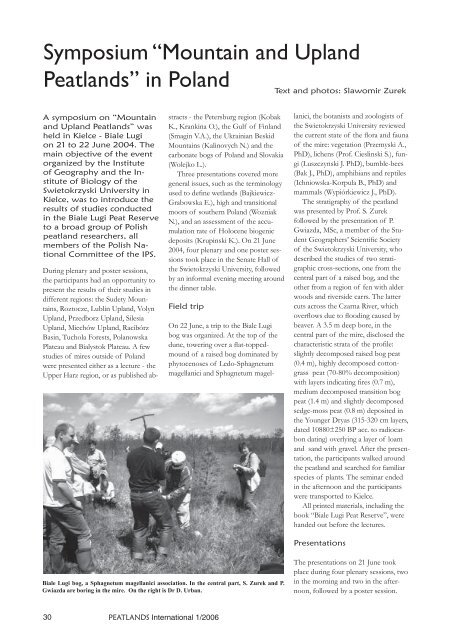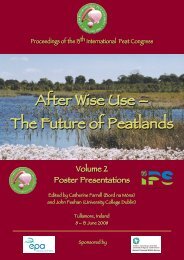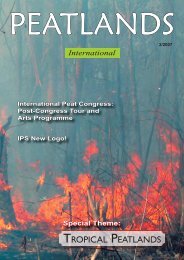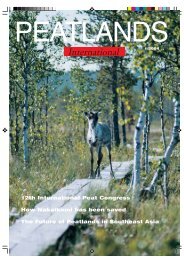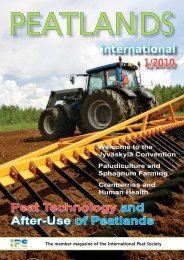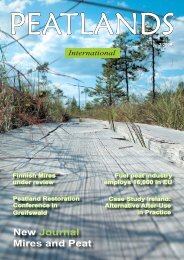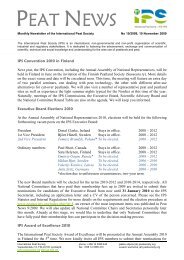peatlands 1 taitto.indd - International Peat Society
peatlands 1 taitto.indd - International Peat Society
peatlands 1 taitto.indd - International Peat Society
You also want an ePaper? Increase the reach of your titles
YUMPU automatically turns print PDFs into web optimized ePapers that Google loves.
Symposium “Mountain and Upland<br />
<strong>Peat</strong>lands” in Poland<br />
A symposium on “Mountain<br />
and Upland <strong>Peat</strong>lands” was<br />
held in Kielce - Biale Lugi<br />
on 21 to 22 June 2004. The<br />
main objective of the event<br />
organized by the Institute<br />
of Geography and the Institute<br />
of Biology of the<br />
Swietokrzyski University in<br />
Kielce, was to introduce the<br />
results of studies conducted<br />
in the Biale Lugi <strong>Peat</strong> Reserve<br />
to a broad group of Polish<br />
peatland researchers, all<br />
members of the Polish National<br />
Committee of the IPS.<br />
During plenary and poster sessions,<br />
the participants had an opportunity to<br />
present the results of their studies in<br />
different regions: the Sudety Mountains,<br />
Roztocze, Lublin Upland, Volyn<br />
Upland, Przedborz Upland, Silesia<br />
Upland, Miechów Upland, Racibórz<br />
Basin, Tuchola Forests, Polanowska<br />
Plateau and Bialystok Plateau. A few<br />
studies of mires outside of Poland<br />
were presented either as a lecture - the<br />
Upper Harz region, or as published ab-<br />
30 PEATLANDS <strong>International</strong> 1/2006<br />
stracts - the Petersburg region (Kobak<br />
K., Krankina O.), the Gulf of Finland<br />
(Smagin V.A.), the Ukrainian Beskid<br />
Mountains (Kalinovych N.) and the<br />
carbonate bogs of Poland and Slovakia<br />
(Wolejko L.).<br />
Three presentations covered more<br />
general issues, such as the terminology<br />
used to defi ne wetlands (Bajkiewicz-<br />
Grabowska E.), high and transitional<br />
moors of southern Poland (Wozniak<br />
N.), and an assessment of the accumulation<br />
rate of Holocene biogenic<br />
deposits (Krupinski K.). On 21 June<br />
2004, four plenary and one poster sessions<br />
took place in the Senate Hall of<br />
the Swietokrzyski University, followed<br />
by an informal evening meeting around<br />
the dinner table.<br />
Field trip<br />
On 22 June, a trip to the Biale Lugi<br />
bog was organized. At the top of the<br />
dune, towering over a fl at-toppedmound<br />
of a raised bog dominated by<br />
phytocenoses of Ledo-Sphagnetum<br />
magellanici and Sphagnetum magel-<br />
Biale Lugi bog, a Sphagnetum magellanici association. In the central part, S. Zurek and P.<br />
Gwiazda are boring in the mire. On the right is Dr D. Urban.<br />
Text and photos: Slawomir Zurek<br />
lanici, the botanists and zoologists of<br />
the Swietokrzyski University reviewed<br />
the current state of the fl ora and fauna<br />
of the mire: vegetation (Przemyski A.,<br />
PhD), lichens (Prof. Cieslinski S.), fungi<br />
(Luszczynski J. PhD), bumble-bees<br />
(Bak J., PhD), amphibians and reptiles<br />
(Ichniowska-Korpula B., PhD) and<br />
mammals (Wypiórkiewicz J., PhD).<br />
The stratigraphy of the peatland<br />
was presented by Prof. S. Zurek<br />
followed by the presentation of P.<br />
Gwiazda, MSc, a member of the Student<br />
Geographers’ Scientifi c <strong>Society</strong><br />
of the Swietokrzyski University, who<br />
described the studies of two stratigraphic<br />
cross-sections, one from the<br />
central part of a raised bog, and the<br />
other from a region of fen with alder<br />
woods and riverside carrs. The latter<br />
cuts across the Czarna River, which<br />
overfl ows due to fl ooding caused by<br />
beaver. A 3.5 m deep bore, in the<br />
central part of the mire, disclosed the<br />
characteristic strata of the profi le:<br />
slightly decomposed raised bog peat<br />
(0.4 m), highly decomposed cottongrass<br />
peat (70-80% decomposition)<br />
with layers indicating fi res (0.7 m),<br />
medium decomposed transition bog<br />
peat (1.4 m) and slightly decomposed<br />
sedge-moss peat (0.8 m) deposited in<br />
the Younger Dryas (315-320 cm layers,<br />
dated 10880±250 BP acc. to radiocarbon<br />
dating) overlying a layer of loam<br />
and sand with gravel. After the presentation,<br />
the participants walked around<br />
the peatland and searched for familiar<br />
species of plants. The seminar ended<br />
in the afternoon and the participants<br />
were transported to Kielce.<br />
All printed materials, including the<br />
book “Biale Lugi <strong>Peat</strong> Reserve”, were<br />
handed out before the lectures.<br />
Presentations<br />
The presentations on 21 June took<br />
place during four plenary sessions, two<br />
in the morning and two in the afternoon,<br />
followed by a poster session.


